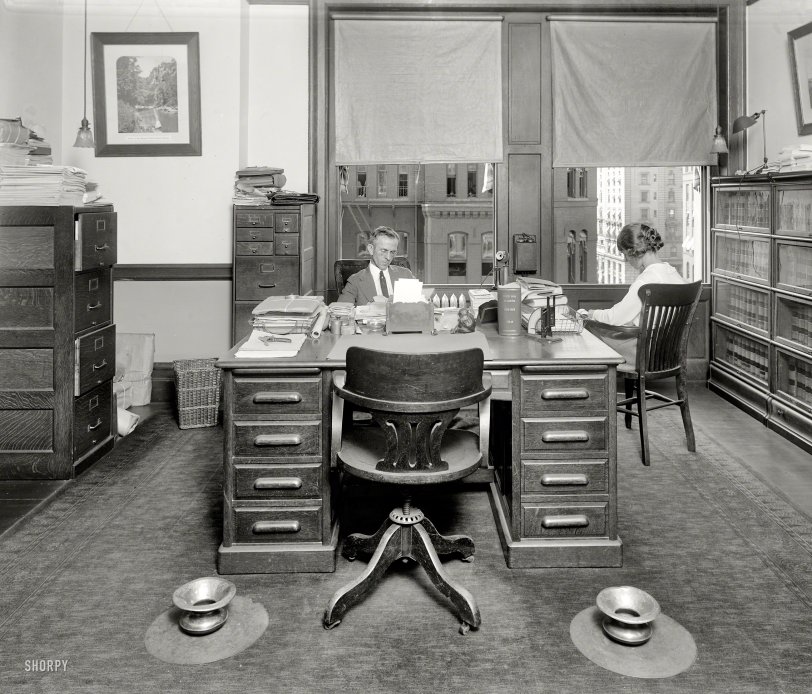


Framed or unframed, desk size to sofa size, printed by us in Arizona and Alabama since 2007. Explore now.
Shorpy is funded by you. Patreon contributors get an ad-free experience.
Learn more.

- Freeze Frame
- Texas Flyer wanted
- Just a Year Too Soon
- WWII -- Replacing men with women at the railroad crossing.
- Yes, Icing
- You kids drive me nuts!
- NOT An Easy Job
- I wonder
- Just add window boxes
- Icing Platform?
- Indiana Harbor Belt abides
- Freezing haze
- Corrections (for those who care)
- C&NW at Nelson
- Fallen Flags
- A dangerous job made worse
- Water Stop
- Passenger trains have right of way over freights?
- Coal
- Never ceases to amaze me.
- Still chuggin' (in model form)
- Great shot
- Westerly Breeze
- For the men, a trapeze
- Tickled
- Sense of loneliness ...
- 2 cents
- Charm City
- What an Outrage
- Brighton Park
Print Emporium
Spit and Polish: 1923

Washington, D.C., circa 1923. "Traffic World office." Tobacco-friendly on both the left and the right. Harris & Ewing Collection glass negative. View full size.
14th and F Street NW
I think the view out the window is looking south on 14th Street NW from the northwest corner of F and 14th Street NW. The Willard Hotel is visible down the street on the right.
The small building containing the spittoon-festooned office at the time was only two stories tall. Around 1990, the building was renovated and only the stone facade was saved. Seven more stories were added, and several adjoining small buildings were totally demolished. The architectural motif of the building on the corner was extended north and east to clad all the hulking new construction.
Spitoons in the Office?
My boss was using one when he retired in 1978....
Old meets new
Picked up the same desk lamp on the book case in the upper right hand side of the picture at thrift shop 40 years ago for a couple dollars. Now used on my computer table.
Colorado Building
It appears that the office is on the south wall in the southwest corner of the Colorado Building located at 14th and G Streets, NW. The northeast corner of the Willard Hotel located at 14th and F Streets can be seen through the window down 14th.
Shut those windows
If a cold evening is expected. That looks like a brass monkey on the desk.
Quality File Cabinets.
I love that cabinet on the back wall with 5 little drawers at the top. They don't make them like that anymore, or with that level of quality. The folks in Sandusky prefer pressed steel.
Who's who
I'll bet he just can't wait for Who's Who in America 1923-1924
A little too cozy
I remember many years ago when I first started in the business I'm still in today (long after this photo was taken I'm happy to report), we had desks with an arrangement similar to these old "partner" desks. Management had pushed them against each other, front to front, so that I sat looking at my co-worker all day. One particular character that sat across from me for a while, sported a moustache that quite resembled a cow catcher on the front of an old steam locomotive. Each day he would return to the office about 1 o'clock with a goodly portion of his lunch embedded in it. I was most productive in the afternoons, never looking up from what was on my desk, and keeping my nose to the proverbial grindstone. For better or worse, cubicles have their advantages.
Chaw Protection
Interesting how the spittoons each have their own little mat underneath to protect the carpet from bad aim.
I wonder what they are made of? They almost look like the plastic you would find today in a chair mat, but I don't know if that type of material was available then. In fact, the chairs don't even have any type of mat underneath.
1923 Tech
A vintage 1923 word processor was in use as well. I wonder, is that a stapler toward the right side on the unused desk? If not does anyone know what that contraption is?
[It's a postal scale. -tterrace]
By golly it is. Thank you.

Balanced
A tip of the hat to the photographer who has balanced his indoor lighting perfectly with the exterior seen through the windows. Not an easy task today, let alone in 1923.
Willard
That building beyond the lovely young lady's head is the Willard Hotel. I've never stayed there, but I hear that it's nice.
Late, But Unlamented
I can recall when banks had a cuspidor (or "spittoon") at each teller's window and they punctuated the rows of benches in train stations, usually brimming with their attractive contents: phlegm, cigar butts, and many, many microbes.
Their care and cleaning must have brought a feeling of great personal fulfillment to their custodians.
When did spittoons disappear from offices?
I would have guessed they'd be gone by 1923, but apparently not.
























On Shorpy:
Today’s Top 5